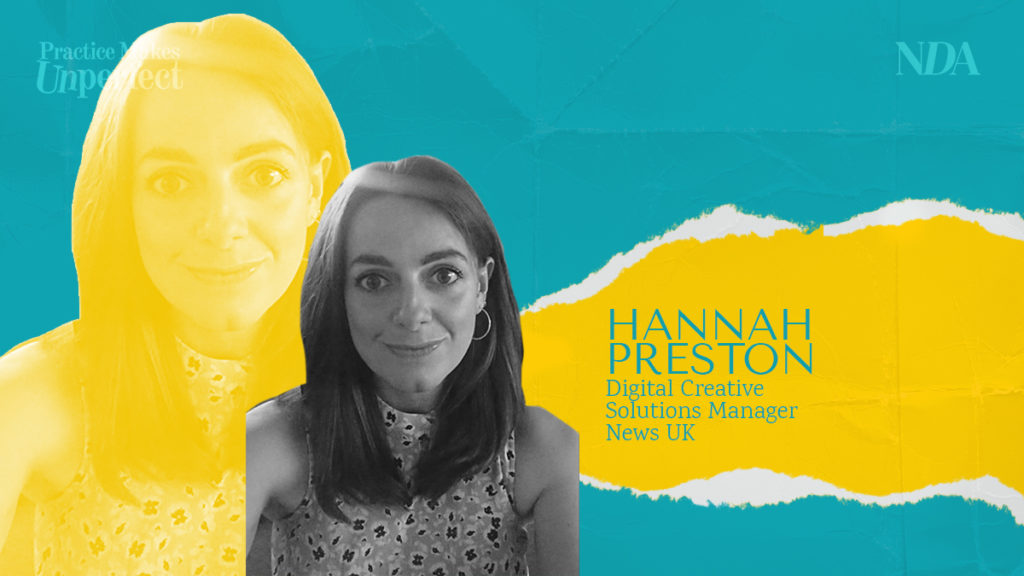These articles have been written by the latest cohort of the Practice Makes UnPerfect programme – a course that helps women find and finesse their public voices.
By Hannah Preston, Digital Creative Solutions Manager at News UK
Close your eyes and picture a senior creative. Who are they? What are they wearing?
Asking colleagues in the advertising industry to do this exercise tends to yield similar results: there’s usually a comment about their jeans, their shoes, and whether they wear a jaunty hat. In London, people sometimes add in an adjective like Shoreditch-y or Peckham-ish. But consistently the response is male and white.
Why are women not seen as creative leaders in our industry? There’s obviously a myriad of factors in play, but the stereotype of a ‘creative’ person is ingrained in all aspects of our culture, and starts in childhood. At school, boys are given more freedom; they speak up more in class, but are also spoken to more and allocated a greater percentage of the teacher’s attention. A Golombok and Fivush study, 1994, observed that in classrooms, girls are more likely to be praised for being “good” and boys more likely to be reprimanded for being “bad”. This pattern can be seen in the workplace, where women are routinely complimented for being “organised”.
A 2015 study from Duke University found that creativity is more strongly associated with masculine characteristics, and that men’s work is more likely to be deemed creative and their ideas considered “ingenious”. The team behind the study asked people to blind assess the creativity of different pieces of work, then compared with how creative the work was perceived to be when the assessor was aware of gender. Throughout the study men were “ascribed more creativity than women, even when producing identical outputs”.
Conversely, women are seen as less creative but more organised in almost every area of work, including preparing for important meetings, implementing filing systems and keeping a tidier desk.
In many workplaces across the industry it has become acceptable for male creatives to frame themselves as an ideas generator, rather than someone who will work to implement these ideas. Women are often left to deal with the logistics, coordination and admin by men who deem themselves as “not a details guy” or not able to use a booking or CRM system. If required to do admin, some people have found that by doing it badly enough times someone – most likely a female or a junior staff member – will pick up after them. Everybody knows that making a bad cup of tea at work will result in rarely being asked, and the same is true of other menial or administrative tasks. Pointing out mistakes or asking for work to be redone is often seen as “nagging”, a term that’s weaponised against women outside of the workplace too.
As well as the dichotomy of being viewed as either creative or organised (when it is possible, and in fact preferable, to be both) there is also the simple fact that new ideas need space to emerge, with stress and time constraints both killing creativity. Any time spent spinning plates that belong to other people is time and energy away from your own projects.
Women are more likely to take on collaborative tasks, which is sometimes to the detriment of their ‘spotlight’ projects that are more likely to lead to promotion. A study by Cassandra Guarino of UC Riverside and Victor Borden of Indiana University, found that female professors do more committee service work and less research than male professors do. Another study (Babcock, Recalde, Vesterlund and Weingart) looked at “the allocation of a task that everyone prefers be completed by someone else” and found that women received 44% more requests than men to take on these tasks.
So what’s the answer? This isn’t a case of men being innately more creative, as it’s clear that gender has no effect on innovation but only on the perception of innovation. It’s also not the case that women are innately more organised, only that we are framed as being so.
The first step is that processes need to be upheld from the top, ensuring that women aren’t being unfairly weighted with organisational responsibility that keeps them away from idea generation and innovation. It’s also important that women’s ideas are heard and considered without bias. Many women report having their creative ideas rejected, only to be submitted again by a man and applauded as a good idea. A study from University of Delaware found that “men are given more credit than women even when saying the exact same thing” in workplaces (“Women get less credit than men”, 2017), something that led academic Jessica Fink to coin the term “Bropropriation”.
If your company is suffering from creative disparity, perhaps it’s time to re-look at the way brainstorms are run. Simple steps like formalising and rotating who runs sessions (and always rotating who takes notes), investing in one of the brainstorming software packages available, or ask for ideas to be submitted anonymously before, during or after a session. There are also options to form small groups with one speaker, so the rest of the room is unaware of an idea’s originator. It’s also important, as with all unconscious bias, to make employees and managers aware that this happens through training and education.
What can you do if your workplace is slow to instigate these behaviours, or you’re working in a male majority environment? If you’re a man, please consider stepping up to take on more tasks that benefit the team, rather than you as an individual. Even if it’s just taking the notes in a meeting instead of your female peer! Although easier said than done, women who step away from organisational responsibilities free themselves up for other tasks.
An arts development director once told me the first thing she does in any role is request an assistant: “Once you start doing admin, that’s all you end up doing. I never learn to use the system so nobody can ever ask me to.” It may be bold, but it certainly removes temptation from helping out, just this once. As Professor Aaron Kay, who was part of the team who conducted the Duke study, says “As our economy becomes more and more based on innovation, this bias is going to matter more and more. If we think creative behaviour is more desirable, then it’s even more important to be aware of stereotypes about creativity.” We are not your mothers.












